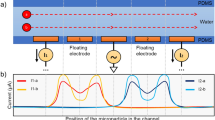Abstract
We present the use of a microfabricated device for impedance-based detection of a few live bacterial cells. Impedance-based detection relies on measuring changes in the AC impedance of two electrodes immersed in a liquid were the bacteria are cultured, caused by the release of ionic species by metabolizing bacterial cells. Rapid detection of a few cells (1 to 10) is possible if the cells are confined into a volume on the order of nanoliters. A microfluidic biochip prototype has been fabricated to test this miniaturized assay. The conductance of the bacterial suspensions is extracted from measuring their complex impedance in a 5.27 nl chamber in the biochip, at several frequencies between 100 Hz and 1 MHz. Measurements on suspensions of the bacteria Listeria innocua, Listeria monocytogenes, and Escherichia coli in a low conductivity buffer demonstrate that, under the current experimental conditions, the minimum detection level is between 50 and 200 live cells, after two hours of off-chip incubation. Work is in progress to develop techniques for selective capture of bacteria inside the chip, and to minimize background changes in impedance during on-chip incubation.
Similar content being viewed by others
References
P.S. Mead, L. Slutsker, V. Dietz, L.F. McCaig, J.S. Bresee, C. Shapiro, P.M. Griffn, and R.V. Tauxe, “Food-related illness and death in the United States,” Emerging Infectious Diseases, vol. 5, no. 5, pp. 607–625, 1999.
United States Food and Drug Administration, Bacteriological Analytical Manual, Published and Distributed by AOAC International, 8th edition, revision A, 1998.
United States Department of Agriculture, Food Safety and Inspection Service, “FSIS method for the isolation and identification of Listeria monocytogenes from processed meat and poultry products,” Laboratory Communication, no. 57, May 24 1989.
Ruth Eden and Gideon Eden, Impedance Microbiology, Research Studies Press Ltd., John Wiley & Sons Inc., 1984.
M. Wawerla, A. Stolle, B. Schalch, and H. Eisgruber, “Impedance microbiology: Applications in food hygiene,” Journal of Food Protection, vol. 62, no. 12, pp. 1488–1496, 1999.
A.L. Edmiston and S.M. Russell, “A rapid microbiological method for enumeration of Escherichia coli from broiler chicken carcasses,” Journal of Food Protection, vol. 61, no. 10, pp. 1375–1377, 1998.
R. Gómez, R. Bashir, A. Sarikaya, M.R. Ladisch, J. Sturgis, J.P. Robinson, T. Geng, A.K. Bhunia, H.L. Apple, and S.T. Wereley, “Microfluidic biochip for impedance spectroscopy of biological species,” Biomedical Microdevices, vol. 3, no. 3, pp. 201–209, September 2001.
R. Gómez, R. Bashir, and A.K. Bhunia, “Microscale electronic detection of bacterial metabolism,” in press, Sensors and Actuators B-Chemical, June 2002.
R. Pethig, Y. Huang, X.-B. Wang, and J.P.H. Burt, “Positive and negative dielectrophoretic collection of colloidal particles using interdigitated castellated microelectrodes,” Journal of Physics D: Applied Physics, vol. 24, pp. 881–888, 1992.
Author information
Authors and Affiliations
Rights and permissions
About this article
Cite this article
Gómez, R., Ladisch, M.R., Bhunia, A.K. et al. Microfabricated Device for Impedance-Based Detection of Bacterial Metabolism. MRS Online Proceedings Library 729, 46 (2002). https://doi.org/10.1557/PROC-729-U4.6
Published:
DOI: https://doi.org/10.1557/PROC-729-U4.6




